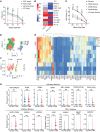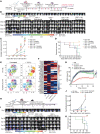Targeting the αv integrin/TGF-β axis improves natural killer cell function against glioblastoma stem cells
- PMID: 34138753
- PMCID: PMC8279586
- DOI: 10.1172/JCI142116
Targeting the αv integrin/TGF-β axis improves natural killer cell function against glioblastoma stem cells
Abstract
Glioblastoma multiforme (GBM), the most aggressive brain cancer, recurs because glioblastoma stem cells (GSCs) are resistant to all standard therapies. We showed that GSCs, but not normal astrocytes, are sensitive to lysis by healthy allogeneic natural killer (NK) cells in vitro. Mass cytometry and single-cell RNA sequencing of primary tumor samples revealed that GBM tumor-infiltrating NK cells acquired an altered phenotype associated with impaired lytic function relative to matched peripheral blood NK cells from patients with GBM or healthy donors. We attributed this immune evasion tactic to direct cell-to-cell contact between GSCs and NK cells via αv integrin-mediated TGF-β activation. Treatment of GSC-engrafted mice with allogeneic NK cells in combination with inhibitors of integrin or TGF-β signaling or with TGFBR2 gene-edited allogeneic NK cells prevented GSC-induced NK cell dysfunction and tumor growth. These findings reveal an important mechanism of NK cell immune evasion by GSCs and suggest the αv integrin/TGF-β axis as a potentially useful therapeutic target in GBM.
Keywords: Brain cancer; Cancer immunotherapy; Immunology; NK cells.
Conflict of interest statement
Figures





References
-
- Jung TY, et al. Immunological characterization of glioblastoma cells for immunotherapy. Anticancer Res. 2013;33(6):2525–2533. - PubMed
Publication types
MeSH terms
Substances
Grants and funding
LinkOut - more resources
Full Text Sources
Molecular Biology Databases
Research Materials
Miscellaneous

